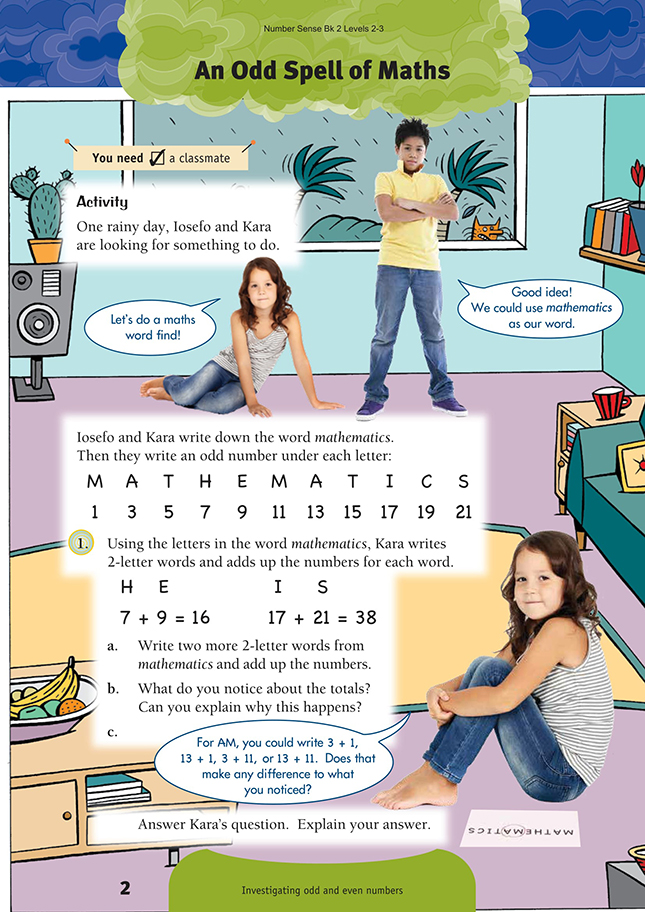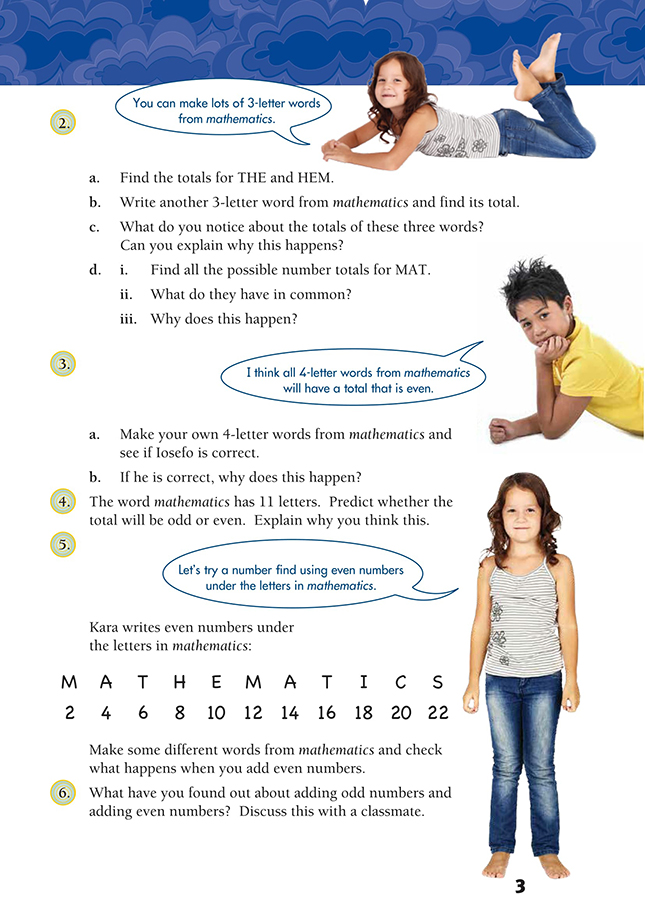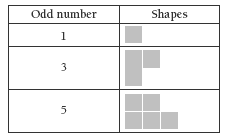This is a level 3 number activity from the Figure It Out series. It relates to Stage 6 of the Number Framework.
A PDF of the student activity is included.
Click on the image to enlarge it. Click again to close. Download PDF (755 KB)
use strategies to solve addition patterns
investigate adding odd and even numbers
Number Framework Links
Use this activity to help the students who are beginning to use early additive strategies (stage 5) to become confident at this stage in the domain of addition and subtraction.
The students using advanced counting strategies (stage 4) could solve the calculations in these problems using materials, but they are unlikely to make the generalisations.
FIO, Levels 2-3, Number Sense and Algebraic Thinking, Book Two, An Odd Spell of Maths, pages 2-3
This activity focuses on exploring and generalising patterns made by combining odd numbers and even numbers in different ways. Another outcome is using strategies to find totals of varying numbers of addends.
Encourage the students in a guided teaching group to explore the interesting and important features in the spelling of the word mathematics. For example, before they even get to question 1c, they may notice that the letters M, A, and T occur twice in the word and that each has a different value.
Ask: Could there be more than one way to make a total from the words that use these letters? Have the students compare the value of the first M with the second M, the first A with the second A, and the first T with the second T. They should see that the second letter is always exactly 10 more than the first. They should also note that all the letter values are odd numbers.
The students who need to use materials could answer question 1b with a visual model. Start with even numbers and represent them by pairs rectangles, such as the ones below, or with groupings of counters or cubes.
Now show the pattern that odd numbers make when we group in pairs (such as a class lining up in twos):
Pattern boards and cubes are ideal materials to use to show these patterns. When the students add 2 odd numbers, they can join these patterns and see that an even number pattern must be the result.
Questions 2 and 3 ask the students to use 3 and then 4 odd number addends. Help your students to make a chart of the findings for questions 1, 2, and 3. It may look like this:
A visual model for seeing the pattern in 3 + 5 = 8 is:
Ask: Can you find a general rule that connects the number of odd number addends with the result?
The students may say: “When you add an even number of odd number addends, you always get an even number. When you add an odd number of odd number addends, you always get an odd number.”
The students need to apply this understanding in question 4, which can be used to evaluate their understanding of this pattern.
When the students make up words with the letters M, A, or T in them, have them compare the results when they choose the first or second of those letters. They should notice that the difference is always an exact number of tens.
In question 5, the students could use groupings of counters or cubes or the even numbers pattern on a pattern board to explore the problem.
A matrix table is a good way of recording the generalisations for adding odd and even numbers in question 6.
Answers to Activity
1. a. Other possible words include:
ME: 1 + 9 = 10 or 11 + 9 = 20
IT: 17 + 5 = 22 or 17 + 15 = 32
AS: 3 + 21 = 24 or 13 + 21 = 34
HI: 7 + 17 = 24
AM: 3 + 1 = 4, 3 + 11 = 14, 13 + 1 = 14, or 13 + 11 = 24
AT: 3 + 5 = 8, 3 + 15 = 18, 13 + 5 = 18, or 13 + 15 = 28
b. The totals are all even. When 2 odd numbers are added together, the result is always evenc. No. Odd + odd always equal even, regardless of what the digits in the tens column (or any other column except ones) are.
2. a. THE: 5 + 7 + 9 = 21 or 15 + 7 + 9 = 31
HEM: 7 + 9 + 1 = 17 or 7 + 9 + 11 = 27
b. Totals will vary, depending on the words chosen. Possible words include: AIM, ASH, ATE, CAT, EAT, HAM, HAS, HAT, HIM, HIS, HIT, ICE, ITS, MAT, MET, SAT, SEA, SHE, SIT, TEA, TIE.
c. The totals are all odd. When 3 odd numbers are added, the total is always odd. 2 odds make an even, and this even number and the next odd number make an odd.
d. i. There are four possible totals for MAT:
1 + 3 + 5 = 9
1 + 13 + 5 = 19
1 + 13 + 15 = 29
11 + 3 + 5 = 19
11 + 13 + 5 = 29
11 + 13 + 15 = 39
ii. They all add up to a number ending in 9, which is an odd number.
iii. The ones digits in the numbers that correspond to each letter are always 1, 3, and 5, which add up to 9.
3. a. Yes, Iosefo is correct. One possible word and its totals is TIME:
5 + 17 + 1 + 9 = 32, 5 + 17 + 11 + 9 = 42,
15 + 17 + 1 + 9 = 42, or
15 + 17 + 11 + 9 = 52
There are more than 40 possible words,
including MEAT (18, 28, 38, 48), HEMS (38, 48), and CAME (32, 42, 52).
b. When 4 odd numbers are added, the total is always even. 2 odd numbers added
together result in an even number. 2 sets of 2 odd numbers equals even + even.
Even + even = even.
4. The total for MATHEMATICS will be odd because it has an odd number of letters (11): 1 + 3 + 5 + 7 + 9 + 11 + 13 + 15 + 17 + 19 + 21 = 121
5. Some possible words and one of their totals include:
HE: 8 + 10 = 18
MAT: 2 + 4 + 6 = 12
THAT: 6 + 8 + 4 + 16 = 34
MATHS: 2 + 4 + 6 + 8 + 22 = 42
When even numbers are added, they always make an even sum.
6. Discussion will vary. You should have found out that odd + odd = even, odd + even = odd, and even + even = even. If you used counters or cubes to explore the numbers, you should have found that showing even numbers with counters
or cubes will always make a complete rectangle of pairs, whereas odd numbers need 1 more or 1 less to make a rectangle of pairs.






